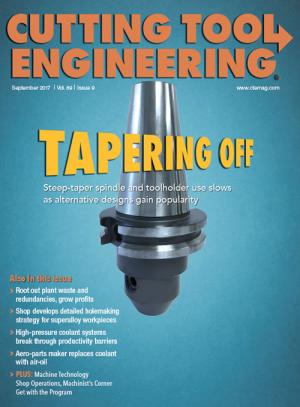 To profitably machine high-quality parts, many manufacturers follow a similar path, beginning with tool selection and application and then solving any problems that arise in a reactive way.
To profitably machine high-quality parts, many manufacturers follow a similar path, beginning with tool selection and application and then solving any problems that arise in a reactive way.
However, research suggests that manufacturers should examine the entire machining process before cutting begins, focusing on eliminating rejected parts and unforeseen downtime.
Manufacturers should take a three-step approach to setting up a machining process:
- Establish a stable, reliable process.
- Analyze production economics to balance production rates and manufacturing costs.
- Carefully select cutting conditions and tools to optimize the machining process.
Consistent product quality is a goal shared by all manufacturers. If machined parts don’t achieve the level of quality specified by the customer, it doesn’t matter how many, how fast or how cost-effectively the parts are machined.
For example, focusing only on maximum output by exclusively pursuing lower cycle times can damage the reliability of a metalworking operation. When an operation constantly runs at the limits of performance, exceeding them results in scrap and lost time and money. Part output must be balanced with machining parameters that provide a secure machining process.
On the other hand, the cause of rejected parts may be a separate issue from the production-related elements of machining. In one instance, a manufacturer of aerospace components didn’t fully deburr a family of parts, making them unacceptable to the customer. Because deburring required manual work that added 20 percent to the cost of the parts, production output became a secondary issue behind the need to find a way to eliminate burr formation.
In addition, minimizing downtime means maximizing the use of manufacturing resources. Traditionally when a problem halts production, a shop begins searching for a solution. A better approach than reacting to a negative situation is to create a proactive plan that recognizes key targets of the operation and steers the process toward them from the beginning.
Most shops spend 20 percent of their time in preparation efforts followed by 80 percent in implementation and testing. The ideal would be to invest 80 percent in preparation and 20 percent in implementation and, if necessary,
making adjustments.
When preparing for a machining operation, a shop should analyze its targets and develop reliable processes to achieve them. The primary target is not always increased production.
In mass production, losing 50 or 100 parts when developing a machining process that will eventually generate hundreds of thousands of parts represents a tiny percentage of the overall volume and can easily be absorbed. However, in a high-mix, low-volume situation, the process must be as fully developed as possible before machining begins. This situation can involve small batches, single-digit lot sizes or even one-offs. In these cases, rejection of a few parts represents the difference between a profit and a loss.
Proactive analysis of a machining operation is time-consuming but of great value. The end use of a machined product — and, thereby, the workpiece material from which it is made — determine many of the important factors affecting process reliability. For example, the machining of critical aerospace components made of nickel-base alloys must be analyzed with the workpiece materials’ poor heat conductivity and tendency to workharden in mind. Use of sharp cutting tools and conservative machining parameters will balance productivity and process reliability.
Conversely, aluminum workpieces are considered free machining, but cutting tools must be sharp and resist wear to withstand the material’s abrasiveness — especially aluminum with a high silicon content. Chipbreakers and peripheral equipment to manage chips, such as high-pressure coolant systems and chip conveyors, also play major roles in assuring reliability when machining aluminum.
CNC and automation systems can help provide a high level of predictability in machining operations, but their effective operation depends on human input. Careless programming, for instance, will result in the highly automated production of defective parts.
Human input is also a factor on the shop floor, where workpiece loading and fixturing and ongoing maintenance of production equipment must be executed properly to prevent unplanned downtime.
Contact Details
Related Glossary Terms
- alloys
alloys
Substances having metallic properties and being composed of two or more chemical elements of which at least one is a metal.
- burr
burr
Stringy portions of material formed on workpiece edges during machining. Often sharp. Can be removed with hand files, abrasive wheels or belts, wire wheels, abrasive-fiber brushes, waterjet equipment or other methods.
- computer numerical control ( CNC)
computer numerical control ( CNC)
Microprocessor-based controller dedicated to a machine tool that permits the creation or modification of parts. Programmed numerical control activates the machine’s servos and spindle drives and controls the various machining operations. See DNC, direct numerical control; NC, numerical control.
- coolant
coolant
Fluid that reduces temperature buildup at the tool/workpiece interface during machining. Normally takes the form of a liquid such as soluble or chemical mixtures (semisynthetic, synthetic) but can be pressurized air or other gas. Because of water’s ability to absorb great quantities of heat, it is widely used as a coolant and vehicle for various cutting compounds, with the water-to-compound ratio varying with the machining task. See cutting fluid; semisynthetic cutting fluid; soluble-oil cutting fluid; synthetic cutting fluid.
- family of parts
family of parts
Parts grouped by shape and size for efficient manufacturing.
- metalworking
metalworking
Any manufacturing process in which metal is processed or machined such that the workpiece is given a new shape. Broadly defined, the term includes processes such as design and layout, heat-treating, material handling and inspection.
—Adapted from an article titled “Take a reverse path to machining success” by Seco Tools LLC, Troy, Mich., at www.secotools.com.


